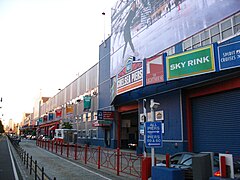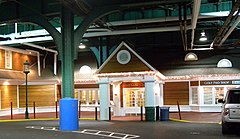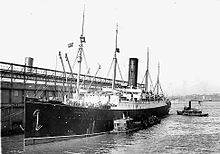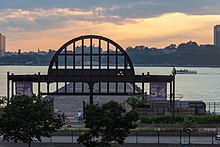
Chelsea is a neighborhood on the West Side of the borough of Manhattan in New York City. The area's boundaries are roughly 14th Street to the south, the Hudson River and West Street to the west, and Sixth Avenue to the east, with its northern boundary variously described as near the upper 20s or 34th Street, the next major crosstown street to the north. To the northwest of Chelsea is the neighborhood of Hell's Kitchen, as well as Hudson Yards; to the northeast are the Garment District and the remainder of Midtown South; to the east are NoMad and the Flatiron District; to the southwest is the Meatpacking District; and to the south and southeast are the West Village and the remainder of Greenwich Village. Chelsea is named after the Royal Hospital Chelsea in London, England.

North River is an alternative name for the southernmost portion of the Hudson River in the vicinity of New York City and northeastern New Jersey in the United States.

Lusitania was an ocean liner that was launched by the Cunard Line in 1906 and held the Blue Riband appellation for the fastest Atlantic crossing in 1908. It was briefly the world's largest passenger ship until the completion of the Mauretania three months later. She was sunk on her 202nd trans-Atlantic crossing, on 7 May 1915, by a German U-boat 11 miles (18 km) off the Old Head of Kinsale, Ireland, killing 1,199 passengers and crew.

Aquitania was an ocean liner of the Cunard Line in service from 1914 to 1950. She was designed by Leonard Peskett and built by John Brown & Company in Clydebank, Scotland. She was launched on 21 April 1913 and sailed on her maiden voyage from Liverpool to New York on 30 May 1914. She was given the title of Royal Mail Ship (RMS) like many other Cunard ocean liners since she carried the royal mail on many of her voyages. Aquitania was the third in Cunard Line's grand trio of express liners, preceded by RMS Mauretania and RMS Lusitania, and was the last surviving four-funnelled ocean liner. Shortly after Aquitania entered service, World War I broke out, during which she was first converted into an auxiliary cruiser before being used as a troop transport and a hospital ship, notably as part of the Dardanelles Campaign.

Mauretania was an ocean liner designed by Leonard Peskett and built by Wigham Richardson and Swan Hunter on the River Tyne, England for the British Cunard Line, launched on the afternoon of 20 September 1906. She was the world's largest ship until the launch of RMS Olympic in 1910. Mauretania captured the eastbound Blue Riband on the maiden return voyage in December 1907, then claimed the westbound Blue Riband for the fastest transatlantic crossing during her 1909 season. She held both speed records for 20 years.

The Joe DiMaggio Highway, commonly called the West Side Highway and formerly the Miller Highway, is a 5.42-mile-long (8.72 km) mostly surface section of New York State Route 9A (NY 9A), running from West 72nd Street along the Hudson River to the southern tip of Manhattan in New York City. It replaced the West Side Elevated Highway, built between 1929 and 1951, which was shut down in 1973 due to neglect and lack of maintenance, and was dismantled by 1989. North of 72nd Street the roadway continues north as the Henry Hudson Parkway.

The Port of Liverpool is the enclosed 7.5-mile (12.1 km) dock system that runs from Brunswick Dock in Liverpool to Seaforth Dock, Seaforth, on the east side of the River Mersey and the Birkenhead Docks between Birkenhead and Wallasey on the west side of the river. The port was extended in 2016 by the building of an in-river container terminal at Seaforth Dock, named Liverpool2. The terminal can berth two 14,000 container Post-Panamax ships.

Riverside South is an urban development project in the Lincoln Square neighborhood of the Upper West Side of Manhattan, New York City. It was originated by six civic associations – The Municipal Art Society, Natural Resources Defense Council, New Yorkers for Parks, Regional Plan Association, Riverside Park Fund, and Westpride – in partnership with real estate developer Donald Trump. The largely residential complex, located on the site of a former New York Central Railroad yard, includes Freedom Place and Riverside Center. The $3 billion project is on 57 acres (23 ha) of land along the Hudson River between 59th Street and 72nd Street.

Thirteenth Avenue was a street in the New York City borough of Manhattan, New York City. It was built in 1837 along the Hudson River. The avenue was later removed in the early 20th century to make way for the Chelsea Piers.
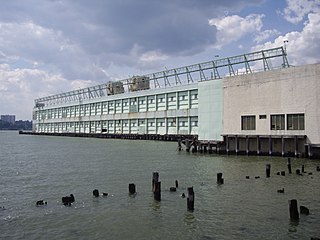
Pier 57 is a long pier located in the Hudson River on the West Side of Manhattan in New York City. Opened in December 1954, it sits at the end of West 15th Street on Eleventh Avenue, just south of the Chelsea Piers sports complex and just north of Little Island. It underwent renovations starting in the early 2010s, and is currently operated by Google. In addition to serving as a campus for employees, the pier opened to the public in April 2023.

Sir Arthur Henry Rostron, KBE, RD, RNR was a British merchant seaman and a seagoing officer for the Cunard Line. He is best known as the captain of the ocean liner RMS Carpathia, when it rescued the survivors from the RMS Titanic after the ship sank in 1912 in the middle of the North Atlantic Ocean.
Daniel Allen Butler is an American author and playwright, who writes on historical topics, particularly maritime history. The Washington Times described him as a "steamship nut".

Hudson River Park is a waterfront park on the North River that extends from 59th Street south to Battery Park in the New York City borough of Manhattan. The park, a component of the Manhattan Waterfront Greenway, stretches 4.5 miles (7.2 km) and comprises 550 acres (220 ha), making it the second-largest park in Manhattan after the 843-acre (341 ha) Central Park.

The Manhattan Cruise Terminal, formerly known as the New York Passenger Ship Terminal or Port Authority Passenger Ship Terminal is a ship terminal for ocean-going passenger ships in Hell's Kitchen, Manhattan, New York City. It was constructed and expanded in the 1920s and 1930s as a replacement for the Chelsea Piers.
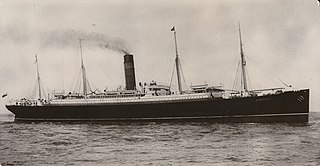
RMS Carpathia was a Cunard Line transatlantic passenger steamship built by Swan Hunter & Wigham Richardson in their shipyard in Wallsend, England.

The first RMS Saxonia was a passenger ship of the British Cunard Line. Between 1900 and 1925, Saxonia operated on North Atlantic and Mediterranean passenger routes, and she saw military service during World War I (1914–1918).

Pier 40 is a parking garage, sports facility, and former marine terminal at the west end of Houston Street in Manhattan, New York, within Hudson River Park. It is home to the New York Knights of the USA Rugby League, though it is primarily used by youth and high school athletics.
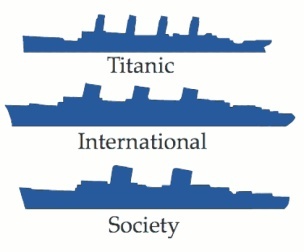
The Titanic International Society is an American 501(c)(3) non-profit organization dedicated to preserving the history of the Titanic and the events surrounding its sinking on April 15, 1912, when more than 1,500 people died. The society holds biennial conventions and occasional special events, such as memorial ceremonies at sites associated with the Titanic and a tribute to Titanic writer Walter Lord in his Baltimore hometown. It is one of several organizations worldwide dedicated to the memory of the Titanic.

Little Island at Pier 55 is an artificial island park in the Hudson River west of Manhattan in New York City, adjoining Hudson River Park. Designed by Heatherwick Studio, it is near the intersection of West Street and West 13th Street in the Meatpacking District and Chelsea neighborhoods of Manhattan. It is located slightly west of the Manhattan shoreline atop Hudson River Pier 55, connected to Hudson River Park in Manhattan by footbridges at 13th and 14th Streets. Little Island has three concession stands, a small stage, and a 687-seat amphitheater.

Chelsea Waterside Park, formerly Thomas F. Smith Park, is a public park located at West 23rd Street between 11th and 12th Avenues along the West Side Highway in Chelsea, Manhattan, New York City. It was originally operated by the government of New York City under the New York City Department of Parks and Recreation. As of 2023 it is part of the Chelsea section of Hudson River Park and managed by the Hudson River Park Trust.

